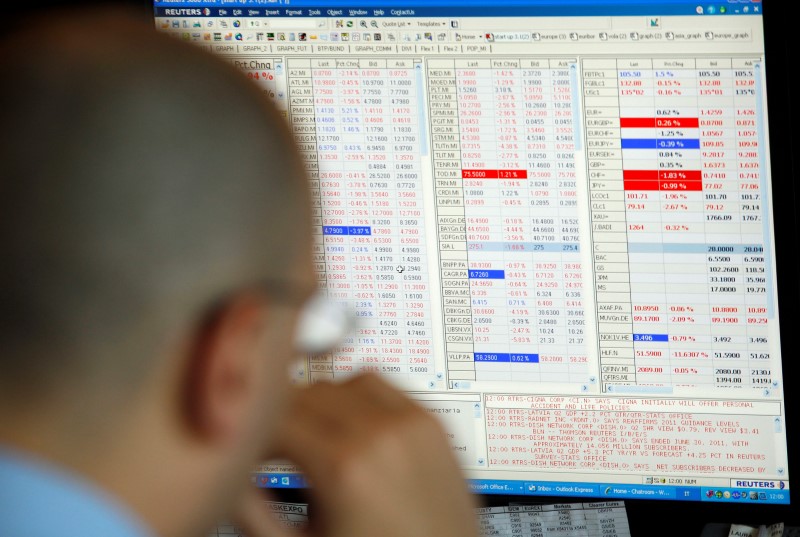© Reuters. FILE PHOTO: Rolled Euro banknotes are placed on U.S. Dollar banknotes in this illustration taken May 26, 2020. REUTERS/Dado Ruvic/Illustration/File Photo
By Harry Robertson
LONDON (Reuters) – Many of the world’s biggest bond funds are facing their third straight year of losses for the first time in roughly 40 years, as a relentless U.S. economy sends bond yields to their highest levels in more than a decade.
Yet far from being put off, investors are loading up on bonds again in 2023 after bailing out of the market last year, drawn in by the same run-up in yields that has caused so much pain.
U.S. diversified bond funds – which invest in public and corporate debt – are on track for a third year of negative returns, after losing more than 10% in 2022, Morningstar data shows.
European funds have effectively returned nothing this year after two down years. Government bond funds have fared even worse and are set to fall for a third year in both the U.S. and Europe, according to figures from Morningstar and data provider EPFR.
“The repricing has been quite aggressive – I would say brutal,” said Stefano Fiorini, global fixed income fund manager at Generali (BIT:) Investments Partners.
The main driver in the years-long sell-off has been central banks’ rapid interest rate hikes to tame inflation.
More recently, the culprit has been a U.S. economy that has ploughed ahead despite the Federal Reserve pushing borrowing costs to their highest level in 22 years. Worries about high government debt and central banks stepping out of bond markets have also played a part.
The yield on the 10-year U.S. Treasury note is on track for its third consecutive annual increase for the first time since the economic chaos of the early 1980s, according to Refinitiv data. It climbed above 5% last week to its highest since 2007. Bond yields rise as prices fall, and vice versa.
A Citi index which tracks how strong U.S. economic data has been relative to analysts’ forecasts shows that it is defying all expectations. Many investors think that means the Fed won’t need to cut interest rates any time soon.
“The re-rating in the forecasts has just been incredible in the U.S.,” said Oliver Blackbourn, a multi-asset portfolio manager at Janus Henderson. “(It) has caught everyone out.”
The consolation for bond fund managers is that yields are now far more attractive to investors than three years ago, when they were close to zero. Now, interest income can keep bond fund returns positive even if prices fall further.
On the ICE BofA US Treasury index, for example, a measure called the yield-to-duration ratio shows that yields would have to rise roughly 0.85 percentage points from here to cause price falls big enough to cancel out a year’s worth of interest payments, which currently stand at about 5%.
And many investors still think the U.S. economy will slow at some point and that the Fed will duly cut rates, boosting bonds.
“You’ve got a bit of a buffer, finally,” said Jonas Goltermann, markets economist at consultancy Capital Economics. “Eventually this trade is going to be right, but do you dare to get involved again?”
Roughly $160 billion has flowed into U.S. bond funds this year, according to the Investment Company Institute, after investors pulled around $225 billion last year.
Bank of America said there were $5.6 billion of inflows to long-dated Treasury funds last week, the largest on record.
Investors are typically picking passive exchange-traded funds, which are cheaper and easier to trade, although many big active funds are still seeing cash return.
Yet plenty of investors remain wary of bonds and prefer to camp out in money-market funds, cash-like investments that currently offer high rates of return and less risk.
ICI data shows that U.S. money market funds have ballooned to $5.6 trillion in assets, from $4.6 trillion in October last year.
“The argument is: I just want to hold a fixed income instrument because the carry is much higher,” said Max Kettner, chief multi-asset strategist at HSBC. “That’s fine, but then you sit in the highest yielding instrument, which is cash.”
(This story has been corrected to focus on total returns, instead of three years of falling net asset value of funds, in paragraph 3 and to update the first chart to show total returns of funds)
(Reporting and graphics by Harry Robertson; Editing by Mark Potter)
Read the full article here




